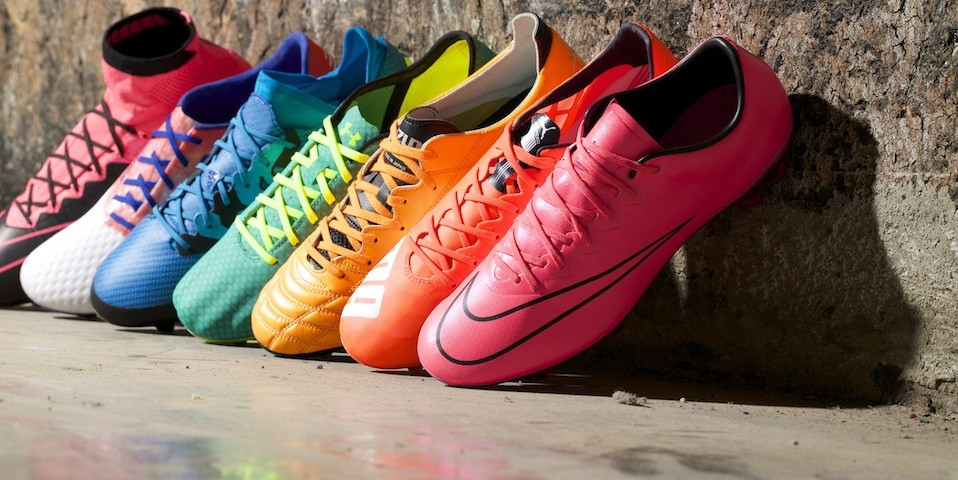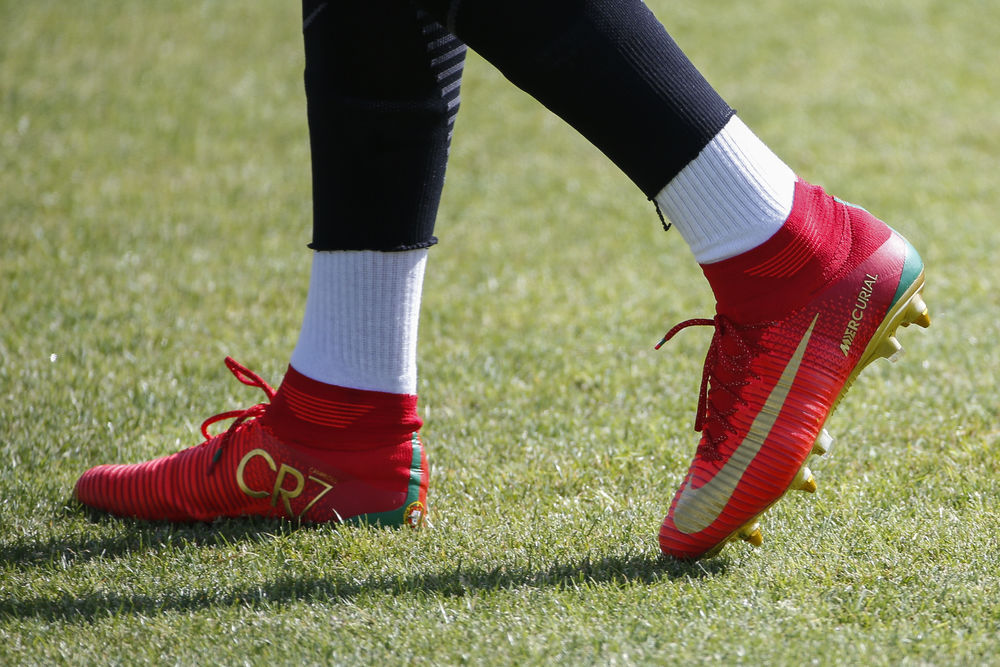Football requires precision, reaction, and stability. Mistakes in equipment choice have a direct impact on speed, ball trajectory, and level of control. Choosing the right footwear not only determines comfort, but also performance, injury frequency, and overall performance on the pitch. Toand develop a competent approach to the choice, the most important parameters must be analysed: Surface, playing style, conditions, material, anatomy of the foot.
The type of surface determines the requirements for the outsole
The playing surface determines the grip, the slippage, and the behaviour of the foot on impact. The answer to the question of which shoes should be used to play football always begins with an analysis of the playing surface.
Natural grass
Classic shoes with long spikes are suitable for natural grass pitches. They ensure deep penetration into the ground, especially after rain or when the surface is loose. The types of studs for this type of ground are known as FG (Firm Ground) or SG (Soft Ground). The former are used for normal ground conditions, the latter for very damp and soft ground.
Artificial turf
Long spikes are ineffective on artificial turf pitches. They do not penetrate the surface and lose stability. Therefore, studded shoes with many short spikes are used, which are usually labelled AG (Artificial Ground). Such shoes distribute the weight evenly over the entire sole and reduce the risk of sprains.
Asphalt, parquet, gymnasium
Futsal or indoor football boots (IC – Indoor Court) are suitable for smooth surfaces. The sole has no spikes but is characterised by a durable, non-slip rubber tread. They are optimised for quick control, sharp turns and secure footing.
Shape and size: a personalised approach to choosing the right shoes for playing football
 The anatomy of the foot determines the size, instep and fit requirements. Without an exact fit, it is impossible to know which shoes are safe and stable to play football in.
The anatomy of the foot determines the size, instep and fit requirements. Without an exact fit, it is impossible to know which shoes are safe and stable to play football in.
Fitting and comfort
The fitting should always be done with a football sock, towards the evening when the foot is still slightly swollen. The shoe should fit snugly around the heel to prevent slipping, but should not squeeze the toes and instep. The right size reduces the risk of blisters and chafing and increases the precision of the shot.
Width of the rubber
Football brands offer models with different widths. A narrow foot requires a customised last, otherwise the shoe will clatter. A wide foot needs freedom at the base of the toe. If this detail is neglected, it leads to deformation of the shoe and chronic discomfort.
Upper material: balance between sensitivity and protection
The upper of the shoe is the most important contact layer. It is the layer that interacts with the ball, reacts to moisture and holds the foot in place. The material determines how the player feels the ball, how much air circulates inside and how long the shoe can withstand the load.
Natural leather – adaptability and softness
Calf or kangaroo leather offers high sensitivity and comfort. The material adapts to the shape of the foot and moulds to the foot over time, creating a personalised fit. Control over the ball can be felt directly – without any intermediate stops. This makes strokes and shots more precise. Leather needs to be cared for. When it gets wet, it loses its shape more quickly than synthetics. In addition, the weight of a leather pair is higher, especially in the rain. Such a top is suitable for technicians and midfielders who need precision and contact, not just speed.
Synthetics – stability, stiffness and water resistance
Modern synthetic materials create a precise geometry and do not deform when exposed to moisture. They make the impact feel a little rougher, but this gives them extra strength. They are easy to clean, do not absorb dirt and retain their appearance and structure for a long time. This option is suitable for attacking players who rely on speed and power rather than just precise technique. Synthetic materials are also lighter than leather, which increases mobility and reduces fatigue during long periods of play.
Mesh hybrids – ventilation and lightweight construction
Hybrids with mesh elements are becoming increasingly popular in futsal and on dry, flat surfaces. They offer maximum air exchange, which reduces overheating and foot perspiration. The weight of the shoe is minimal, so that strong acceleration and quick changes of direction are possible. The disadvantage is the reduced durability. During aggressive play on natural grass, the mesh tears and deforms. Such models are suitable for lightweight players on dry, dense pitches.
Shoe functions: support, control and safety
Football boots influence the dynamics of every action. They determine stability when kicking off, accuracy when dribbling and protection of the joints in the event of collisions. In order to understand in which shoes you can play football as reliably as possible, it is worth evaluating the following parameters.
Grip – stability and trajectory control
Spikes are a crucial element, especially when playing on natural surfaces. They maintain balance when jerking, braking and making lateral movements. The correct shape and length of spikes helps to maintain responsiveness and reduce the risk of slipping. The wrong choice leads to delayed reaction times, unfortunate stumbles and falls. The shape of the spikes varies: conical spikes ensure a smooth glide, paddle spikes maximise grip. Flat or smooth soles are used for synthetic surfaces.
Ball control – contact and density
The upper material determines the behaviour of the ball on the foot. A thin leather shaft makes it possible to feel every millimetre of the ball surface. This is important for round balls, fine passes and spin kicks. The dense synthetic material absorbs some of the impact energy but protects the fingers from hard contact. This is particularly important for strikers who often shoot from below. For training sessions with intensive technique and passing, a leather upper increases efficiency, while for games with hard physical contact it is better to choose synthetics with sealed inserts.
Foot protection and injury prevention
The back, the side inserts and the inner lining serve to cushion and stabilise the foot. The rigid heel stabilises the heel and prevents the foot from slipping. Additional protection in the instep and toe area reduces the likelihood of bruising in the event of a collision. Cushioning under the heel is particularly important for defenders and midfielders. These players are more likely to make contact, jump and move backwards. Without reliable support, the joint is overloaded and loses stability at critical moments.
Approaches to selection according to player type: What footwear should you wear for football?
Which footwear to wear when playing football is a question that depends on the position, tasks and conditions.
- Striker – shoes with minimal weight, thin upper, high sensitivity (leather, synthetic), spikes FG or AG. The aim is explosive speed and powerful impact.
- Midfielders – models with a good balance between grip and control, medium width, with cushioning. Material – Synthetic with texture.
- Defenders – shoes with reinforced toe area, close-fitting, preferably SG on soft ground. Contact play requires a firm fixation.
- Goalkeepers – futsal or studded shoes with short spikes, high stability, reinforced toe area.
- Amateur on a universal pitch – centipedes for AG or TF surfaces, stable upper, medium sole, simple and comfortable.
Conclusion
 Your choice of equipment will determine how well you can participate in the game. Knowing what footwear to wear when playing football will help you avoid mistakes, stay healthy and maximise your potential. The right footwear creates a foundation for growth, confidence and results.
Your choice of equipment will determine how well you can participate in the game. Knowing what footwear to wear when playing football will help you avoid mistakes, stay healthy and maximise your potential. The right footwear creates a foundation for growth, confidence and results.
 en
en  de
de  ar
ar  es
es  nl
nl  hi
hi  fr
fr  it
it  pt
pt  el
el 










